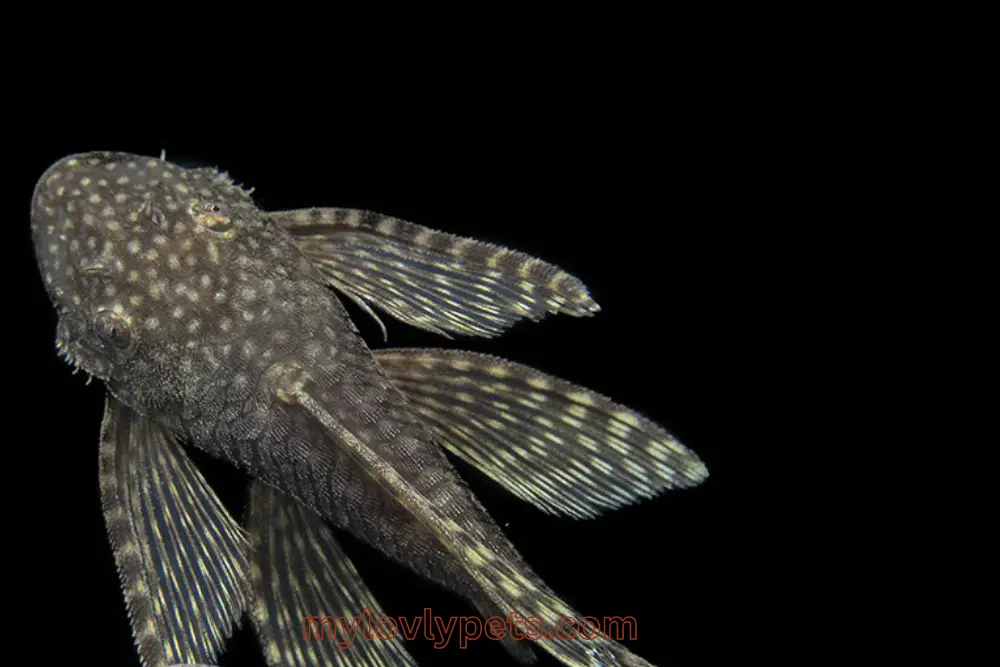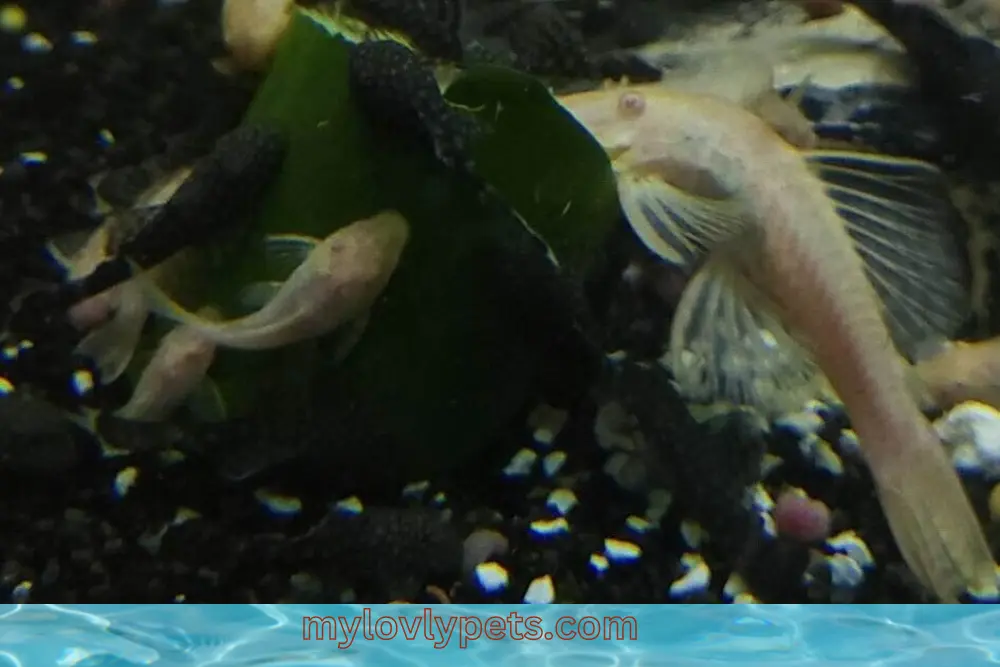
Longfin Bristlenose Plecos: The Perfect Aquarium Beauty
The elegant longfin The Bristlenose Pleco, a remarkable creature, possesses the unique talent of devouring algae and flourishing within the confines of an aquarium. With their graceful swimming and elegant, flowing fins, these creatures captivate observers.
Before welcoming these fascinating creatures into your aquatic sanctuary, it is imperative to acquaint oneself with their captivating visage, meticulous care prerequisites, and other indispensable facets of the aquatic realm. Discover the wisdom of seasoned experts as they unveil invaluable insights into the art of nurturing this magnificent species within the confines of your aquatic sanctuary.
Longfin Bristlenose Plecos: An Overview
| Common Name | Bristlenose Pleco, Longfinned Pleco |
| Scientific name | Ancistrus sp |
| Average adult fish size | 4 – 5.9 inches (10 - 15 cm) |
| Origin | South America |
| Minimum Aquarium Size | 10 Gallon/40 L |
| Diet | Omnivorous |
| Social behavior | Generally solitary |
| Standard tank setup | S. American biotope with rocks, bogwood/driftwood, vegetation, and moderate to strong current |
| Water pH level range | 6.5 - 7.5 |
| Temperature | 71–80(F/22–27C). |
The Longfin Bristlenose Pleco is a unique variant of the Bristlenose Pleco, belonging to the Loricarilidae catfish family. With its elongated fins, the fish possesses a mesmerizing allure, reminiscent of a splendid blend between a Scorpionfish and a goldfish. This renders it a truly breathtaking inclusion to any aquarium.
Novice aquarists are particularly fond of these fish due to their minimal upkeep requirements and remarkable talent for improving water quality. The fish in question hail from the Amazon and other rivers in South America, boasting a modest maximum size of four inches.
The Longfinned Bristlenose plecos are known for their peaceful nature and their role as algae eaters. However, it is important to provide them with appropriate feeding to prevent any damage to aquatic plants. These creatures possess an omnivorous diet and are highly amenable to breeding.
Plecos flourish in gently acidic, balmy waters of moderate hardness. These marvelous creatures are known by various names, such as the Longfinned Bristlenose plecos, Longfin Bristlenose catfish, and Longfin Bushynose plecos.
Longfin Bristlenose Plecos: Appearance

The Longfin Bristlenose, a visually captivating catfish, bears a striking resemblance to other subspecies of Bristlenose plecos. The creatures in question are commonly referred to as “whisker-heads” because of the bristles or whiskers adorning their bony heads.
Behold, the magnificent fish adorned with a remarkable attribute – a wondrous suckermouth adorning the forefront of their graceful bodies. Their unique attribute allows them to graze efficiently on algae and other substances that reside on the surfaces of aquariums.
These fish have streamlined bodies and sturdy bony plates, providing them with excellent defense against aggressive fish.
Male Longfin Bristlenose plecos boast impressive fleshy and elongated tentacles on their heads, whereas females exhibit shorter and more understated tentacles around their mouths. Male fish also possess tentacles on their pectoral fin spines and odontodes on their cheeks and snout.
The Amazonian fish boasts stunning color patterns, allowing it to effortlessly blend into the murky waters. Adorning their dark bodies are spots, yellow or white in hue, resembling tiny pebbles.
The creatures possess fins that exude elegance and grace, enabling them to effortlessly glide through the water with a captivating and enchanting swimming style. The Longfin Bristlenose plecos, though petite, possess an enchanting allure within the confines of an aquarium, courtesy of their splendid fan-shaped fins.
Longfin Bristlenose Plecos: Care
The Longfin, a magnificent aquatic creature, possesses an elongated and graceful body. Its fins, as the name suggests, are Bristlenose plecos, a splendid choice for novice aquarists, boast low-maintenance needs, and a remarkable resilience against common fish ailments.
While these remarkable creatures possess the ability to acclimate themselves to a plethora of tank conditions, it is of utmost importance to provide them with a meticulously maintained environment. This not only ensures their overall well-being but also promotes harmonious coexistence with their aquatic tank companions.
Longfin Bristlenose Plecos: Tank Size and Setup

Creating the perfect habitat for Longfin Bristlenose plecos may prove to be quite the endeavor for those new to the world of aquariums. Creating a faithful replica of the Amazon’s natural habitat is vital for the welfare of our animal friends. For the best conditions, it’s crucial to have enough oxygen, a gentle water current, and warm water temperatures.
Longfin plecos thrive in a 10-gallon fish tank. It is advisable to provide a larger aquarium for these creatures in order to accommodate their coexistence with other fish.
Substrate
Choosing the right substrate for Longfin Bristlenose plecos is of utmost importance. It must encourage their natural foraging instincts while also providing a secure environment for their well-being. Fine or medium-coarse aquarium gravel is often favored by aquarists. Nevertheless, alternative substrates may also prove to be suitable.
Driftwood
Driftwood is essential for the Long Fin Bristlenose pleco in your fish tank. It’s a great way to promote explosive algae growth, giving your plecos plenty of grazing material. Scraping the driftwood surface helps plecos access fibrous material for a healthy digestive system.
When selecting driftwood, opt for softer varieties like Cholla wood, Malaysian driftwood, or grape wood. Hardwood varieties should be avoided as plecos are unable to effectively scrape their surfaces.
Driftwood provides nutritional benefits and is a hiding place for Long Fin Bristlenose plecos. These small fish, measuring three to four inches, are vulnerable to larger predatory fish. Driftwood apertures are great for Longfin Bristlenose pleco eggs, fries, and juveniles.
Plants
When adding plants to your aquarium, it’s crucial to consider the needs of your fish, especially long fin Bristlenose pleco. Aquatic plants can be a great addition to fish tanks, but they can also compete with algae, an important food source for fish.
Choose slow-growing or floating plants that won’t outcompete the algae to strike a balance. Adding plants provides a surface for plecos to attach and feed on algae without harming the plants. If your pleco eats plant leaves, it could mean they need more food.
Artificial Caves
Longfin Bristlenose plecos in the wild protect their eggs from predators using natural underwater caves. You only need an artificial shelter in your tank if you plan on breeding fish or have driftwood. Having one is highly recommended if you want your plecos’ eggs to develop and grow. Artificial caves offer a safe and secure haven for plecos to rest and feel protected.
Filtration And Oxygenation
Having a solid filtration system is crucial for your Longfinned Bristlenose pleco. To maintain a clean environment, it is vital to have an efficient filtration system for these fish due to their high waste production. To conserve water quality and keep the tank clean, it is recommended to use canisters or hang-on-back filters with strong biological and mechanical filtration.
Under-gravel and canister filtration can enhance water oxygenation, benefiting your plecos. Investing in a reliable filtration system ensures a clean and healthy environment for your fish.
Lighting
Bristlenose plecos, being nocturnal fish, don’t need bright lighting. When choosing lighting for your aquarium, consider the needs of your plants. Moderate lighting or LEDs should be sufficient. Ensuring your pleco has enough darkness at night is crucial for its well-being.
Water Parameters
Water parameters are essential for the growth and health of your bristle nose plecos. To maintain optimal conditions for your aquarium, keep the temperature between 72-78°F (22-25°C), pH levels between 6.5-7.5, and water hardness (GH) between 6-10 dGH.
Longfin Bristlenose Plecos: Tank Mates
Ideal tank mates for Bristlenose plecos are peaceful species that do not compete for food or territory. Suitable tank mates for your aquarium include small schooling fish such as neon tetras, platies, mollies, and other peaceful species of similar size. It is essential to avoid housing them with aggressive fish that may cause stress to prevent reduced development.
Also, read:
Do Clown Plecos Need to Be in Groups?
The Ultimate Plecostomus Blue Phantom (L128) Care Guide
Longfin Bristlenose Plecos: Feeding
Feeding them a balanced diet is important to ensure healthy growth in your Bristlenose pleco. To ensure a balanced diet, include a variety of foods like algae wafers, vegetables, and protein-rich options such as bloodworms or brine shrimp.

Algae
In their natural habitat, Bristlenose plecos rely on algae as a vital part of their herbivorous diet. In your aquarium, they help manage algae growth. It’s important to note that relying solely on existing tank algae may not be sufficient.
Algae wafers
Algae wafers are essential for herbivorous fish like Bristlenose plecos. The natural algae in the aquarium might not be sufficient to maintain their health. Choose high-quality wafers from trusted brands to provide your fish with essential nutrients.
Vegetables
Improve your Bristlenose pleco’s diet with blanched vegetables such as zucchini, cucumber, spinach, and lettuce. Including these vegetables in your pet’s diet is essential for providing nutrients and supporting their overall health and growth.
Protein
Bristlenose plecos, despite being herbivorous, can benefit from a small protein intake in their diet. Occasionally, you can give your pets treats like bloodworms or brine shrimp. However, be cautious not to overfeed them to prevent any health problems.
Feeding Frequency
To keep your Bristlenose plecos happy and maintain water quality, it is recommended to feed them once or twice a day in the evening. It is important to remove any uneaten food within 24 hours.
Monitoring Growth and Adjusting Food
To keep your pleco healthy, it’s essential to monitor their growth and adjust their food as needed. If you see slow growth or signs of being underweight, try changing the amount or frequency of their meals.
To promote a healthy and thriving life for your Bristlenose pleco in your aquarium, providing them with a diverse and balanced diet that includes all the necessary nutrients is essential.
Longfin Bristlenose Plecos: Temperament

Despite their unusual appearance, Longfin Bristlenose Plecos are peaceful and gentle fish. These gentle creatures graze on the aquarium’s bottom, maintaining cleanliness and order. They are unconcerned with other fish species, as they are preoccupied with scavenging for food on the substrate floor.
Plecos are highly skilled at camouflage, blending seamlessly with their surroundings due to their stealthy colors and patterns, making them incredibly hard to detect. They frequently conceal themselves in driftwood crevices, artificial caves, or dark hideouts. They are mainly nocturnal, unlike most other fish that sleep at night. They prefer areas abundant in algae and will happily feed until dawn.
Male Longfin Bristlenose plecos can be territorial, particularly during breeding. Creating separate hiding spots or caves for each male is advisable to prevent conflicts. It is possible to keep two males together in a tank as long as it is spacious enough to accommodate multiple territories.


